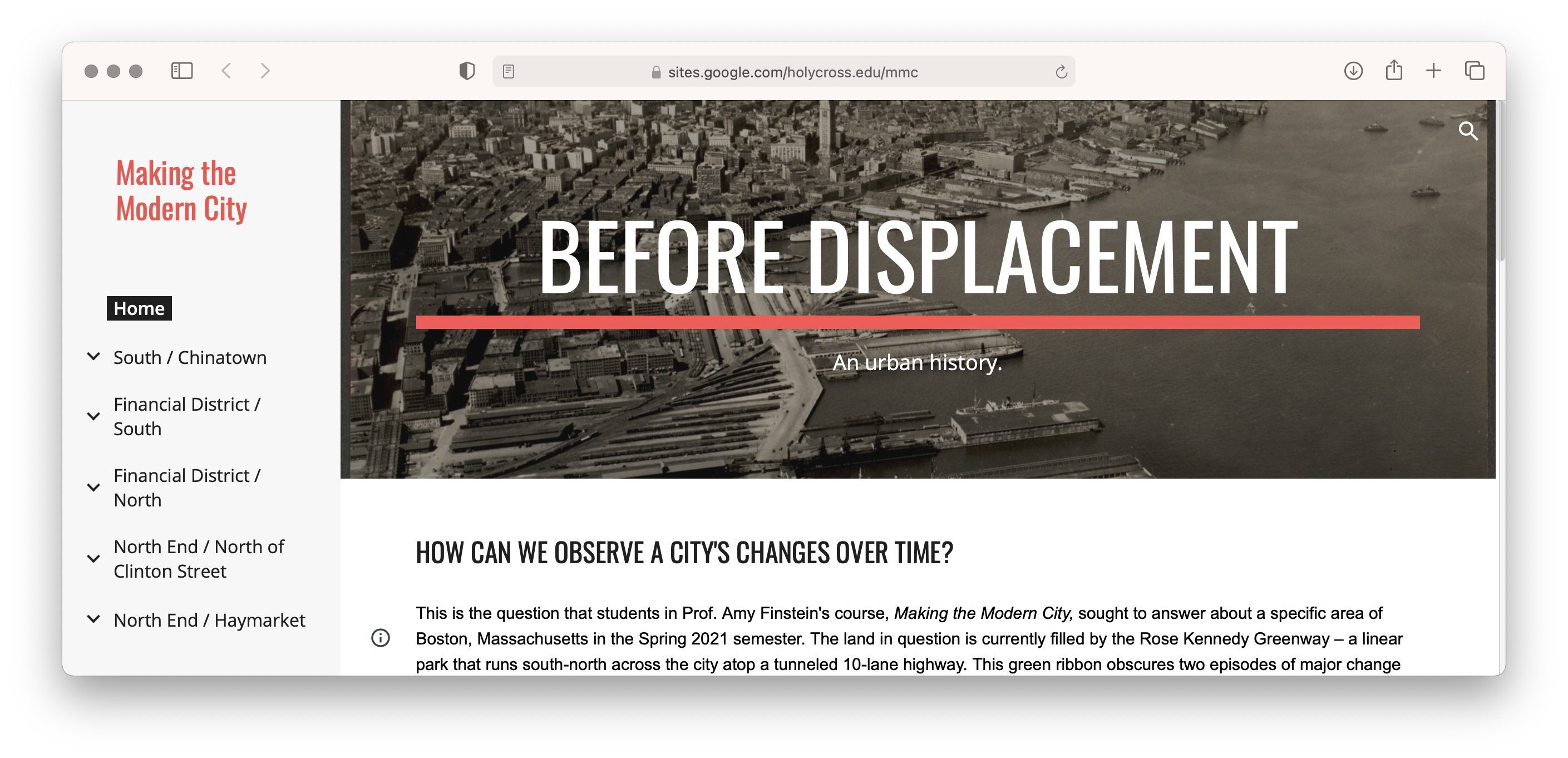In the Spring 2021 semester, my urban history students at College of the Holy Cross undertook a semester-long research project focused on the history of the land currently filled by Boston’s Rose Kennedy Greenway. Before this land became the Greenway in recent years, it hosted an elevated highway—the Central Artery, completed in 1959—and before that, it was filled with buildings and streets.
We wanted to learn about the buildings, business owners, residents, community groups, and infrastructure that occupied this land before the construction of the highway. One of the most invaluable tools in our collective research project was the Atlascope tool built by the Leventhal Map & Education Center. Each student investigated a single parcel of land, and thanks to Atlascope, they were able to mine historic maps for information about the buildings, businesses, and landowners on their parcel. These findings empowered further research in historic newspapers, genealogical records, and archival collections, allowing them to paint detailed pictures of this corridor’s past.

Together, my students and I built a public history website that uses Atlascope maps and other visual material to explore the displaced landscapes of the Central Artery corridor. Read below for short student profiles spotlighting some of the most interesting research discoveries!
—Amy D. Finstein
Shoe and leather businesses on Albany St.
The 1922 Bromley Map led to key findings in my research of the history of the parcel between 1-35 Albany St. After researching some of the names found on this map, I found historical newspaper documents about Jacob & Meyer Pearl, whose names are labelled on units 15-17 where I learned that they owned and operated shoe wholesale stores on this parcel. This led to further inquiry about the types of stores that were found on this block, where I discovered this parcel’s relationship to the Leather District of Boston. Turns out this entire block was filled with shoe and leather businesses up until the units were demolished to make way for the construction of the Central Artery.
—Paige Epp
Fish oil on Atlantic Ave.

Leslie Jones photo of Mercantile Wharf (1928)
The history of Atlantic Avenue is in large part marked by the prominence and success of the fish oil industry due to the plethora of wharves and piers along the harbor, which have always been important and identifying features of Boston as a coastal city. Here’s an 1882 map of my parcel, and an image of Mercantile Wharf at the rear of commercial buildings on Atlantic Avenue.
—Sydney Fisher
Congestion in Clinton Market
Boston’s urban framework inherently provoked mercantile activity. Clinton Market housed this activity and was a landmark on the skyline of the Financial District and North End due to its size and proximity to the wharfs and Faneuil Market. The increased market congestion and rush hour periods forced vendors to share the open floor plan of Clinton Market, increase use of different modes of transportation, such as horses and individual push carts, along with competitive advertising.
—Elyse Cote
Brothels before the Big Dig
A series of domestic and hygiene artifacts excavated from the Big Dig have been studied and traced back to 19th century private brothels on my parcel at 27-29 Endicott Street. Although the establishment was frequented by working class men, the site was operated and led by various women, who took advantage of their social class and conditions to eliminate any suspicions. Beyond moral and legal issues, there is a deeper narrative regarding gender and class in the North End’s 19th century brothels as it allowed for women to have economic independence and as well as a sense of power and ownership.
—Renata Palau
An influential family’s mark on the city
Owning the largest section within my South Market Street parcel (55-121 South Market Street), “Josiah Quincy and Heirs” provides an example of a historically wealthy family who influenced the City of Boston and invested in the South Market mercantile and commercial business area. Josiah Quincy III, former mayor of Boston and developer of Quincy Market, owned several buildings within my parcel that were soon passed down through generations of the Quincy Family. When researching local newspapers, I was fortunate to discover the Quincy patriarchal family tree showcased in a family feature in the Boston Sunday Post in 1919.
—Kristen Weber

Alberth Leman, “The Last of the Quincys” Boston Sunday Post (Oct. 19, 1919): 47.
Keep exploring
Want to read and explore more? Visit the course project website. Want to build something like this for your own university course? Learn more about Leventhal Center resources for university teaching..
Our articles are always free
You’ll never hit a paywall or be asked to subscribe to read our free articles. No matter who you are, our articles are free to read—in class, at home, on the train, or wherever you like. In fact, you can even reuse them under a Creative Commons CC BY-ND 2.0 license.